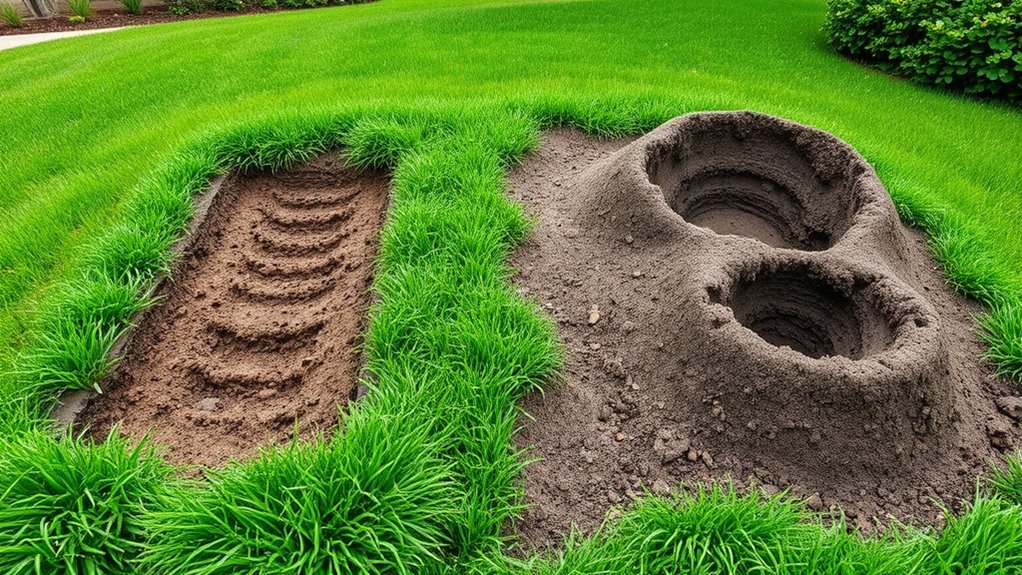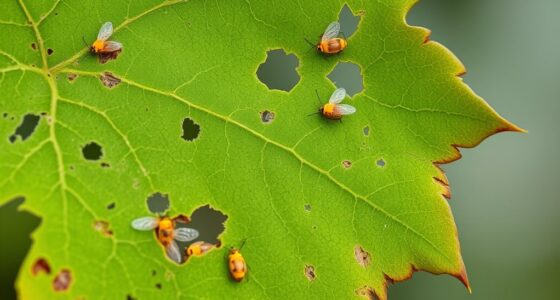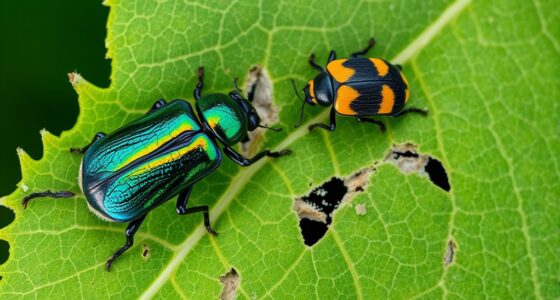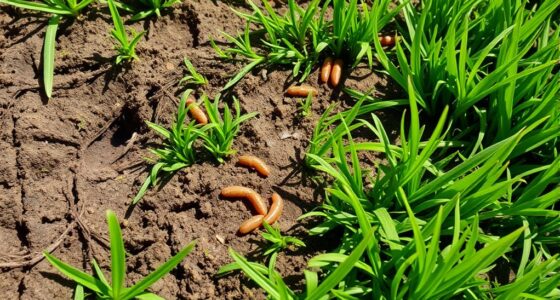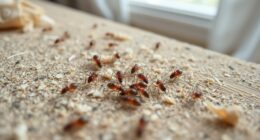Gophers and moles cause different yard damage you can spot easily. Gophers push up crescent-shaped mounds and create loose soil piles on the surface, often damaging roots just below ground. Moles leave raised ridges above underground tunnels, usually less disruptive to the surface but more damaging to root systems below. Recognizing these signs helps you identify the pest quickly. Keep exploring to learn effective ways to manage and prevent their damage in your yard.
Key Takeaways
- Gophers create crescent-shaped surface mounds with loose soil, while moles form raised underground ridges with minimal surface disturbance.
- Gopher tunnels run just below the soil surface, damaging roots and causing visible mounds; moles’ underground tunnels are more linear and less surface-visible.
- Gophers damage lawns and gardens with surface mounds and root destruction; moles primarily tunnel underground, causing soil ridges without significant surface mounds.
- Gophers are often controlled with trapping and barriers targeting surface activity; moles are best managed with underground baiting and trapping.
- Surface mounds and loose soil indicate gopher activity, whereas raised soil ridges suggest mole tunneling beneath the surface.
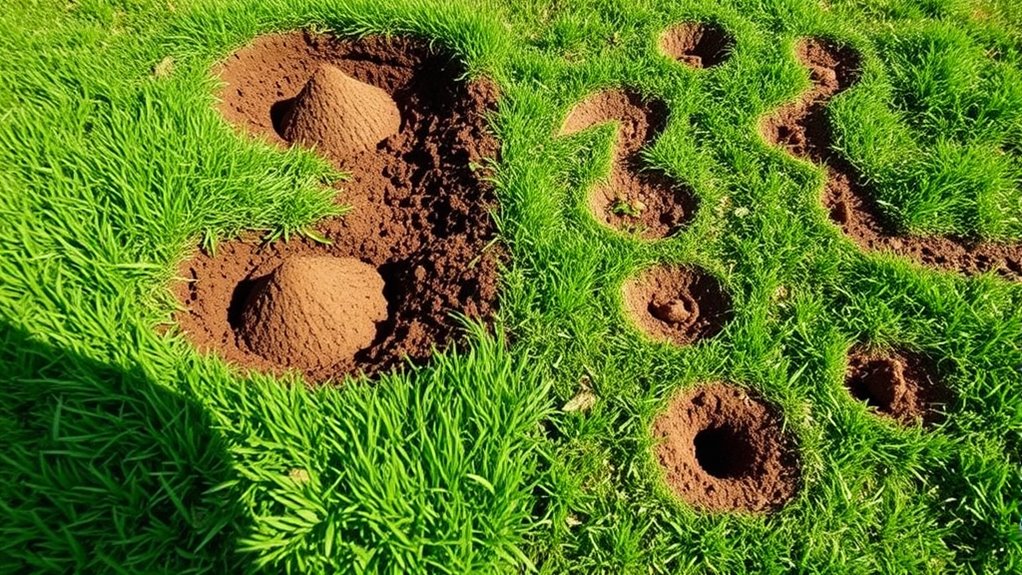
If you’re noticing unusual holes and tunnels in your yard, you might be dealing with gophers or moles, both of which cause distinct types of damage. Recognizing the difference is essential for choosing effective pest control methods and prevention strategies. Gophers typically create surface mounds with loose soil pushed to the surface, often forming crescent-shaped ridges on your lawn. Their tunnels run just below the soil’s surface, damaging roots and making your grass and plants unstable. Moles, on the other hand, usually leave raised ridges of soil caused by their tunneling underground. These tunnels are often more linear and less disruptive on the surface but can severely damage root systems beneath, especially in vegetable gardens or flowerbeds. Additionally, the use of appropriate tools and techniques can significantly improve your chances of successfully managing these pests.
Gophers create surface mounds, while moles leave underground ridges and tunnels.
Understanding these differences helps you target your pest control methods accurately. For gophers, trapping is one of the most effective strategies. You can set traps in active tunnels, which you identify by observing fresh mounds or videos of their activity. Baits and repellents are also options, but they require consistent application and may not always guarantee success. For moles, trapping is also effective, but poison baits are generally discouraged due to potential risks to pets and wildlife. Instead, you might consider installing underground barriers or physically blocking their entry points, especially if you want a long-term solution.
Prevention strategies play a crucial role in reducing future damage. For gophers, maintaining healthy, dense vegetation can make your yard less attractive to them since they prefer loose, soft soil for tunneling. Removing attractive food sources like roots of garden plants or grubbing around your yard can also deter them. For moles, reducing their food supply by controlling grubs and other insects they feed on helps. Installing underground fencing around garden beds or lawn areas can prevent both pests from invading your yard in the first place.
Ultimately, identifying whether gophers or moles are causing your yard damage guides your approach. Both require persistent, targeted efforts that combine pest control methods with prevention strategies to protect your landscape. Regularly inspecting your yard for signs of activity and acting promptly can save you from more extensive damage down the road. Remember, a combination of trapping, barriers, and habitat modification provides the best chance for long-term control and a healthier, more resilient yard.
Frequently Asked Questions
How Can I Prevent Gopher and Mole Infestations Naturally?
To prevent gopher and mole infestations naturally, start with habitat modification by removing their food sources and clearing dense vegetation. Use natural repellents like castor oil or garlic sprays to discourage them from settling. You can also introduce predator-friendly plants or set up barriers underground. Regularly inspect your yard, and maintaining a healthy, less appealing environment will help keep these pests at bay without chemicals.
Are Gophers or Moles More Harmful to Vegetable Gardens?
Imagine your garden as a canvas of growth; gophers are more damaging because their tunnels, often forming extensive burrow patterns, destroy roots and undermine plants. Moles, leaving surface trails, mainly feed on insects and don’t disrupt roots as much. So, if you notice gopher burrow patterns, your vegetable garden faces greater harm, making gophers the more destructive pest for your crops.
What Signs Distinguish Gopher Tunnels From Mole Runways?
You can distinguish gopher tunnels from mole runways by observing the surface signs. Gopher tunnels often have a visible, mound-like entrance with fresh soil deposits and a surface tunnel that appears more rounded and plugged. In contrast, mole runways are typically shallow, with a smooth, raised surface trail without mounds, and the tunnel surface remains less noticeable. Check for these signs to identify the type of burrowing animal in your yard.
Can Pets or Children Be Harmed by Gophers or Moles?
Pets and children are generally safe around gophers and moles, but you should still exercise caution. Gophers can bite if threatened, and their tunnels might cause tripping hazards. Moles are less aggressive but can disturb soil, possibly leading to hidden holes. To guarantee pet safety and child safety, keep an eye on play areas, discourage digging near tunnels, and consider humane removal methods if pests become problematic.
What Long-Term Control Methods Are Most Effective?
Have you considered long-term control methods? You should combine trapping strategies with natural repellents for the best results. Trapping effectively reduces populations over time, while natural repellents like castor oil or planting certain plants can deter these pests sustainably. Are you willing to invest a bit of effort now to protect your yard long-term? Consistency is key, so stay persistent and adapt your approach as needed for lasting success.
Conclusion
So, now you see how gophers and moles cause different yard damage. While gophers tunnel underground, creating raised mounds and destroyed roots, moles tunnel just beneath the surface, leaving surface ridges and empty tunnels. Don’t assume you need expensive traps for both; understanding which pest you face makes treatment easier. If you spot those distinctive signs, you can act quickly to protect your yard—saving time, money, and your peace of mind.
